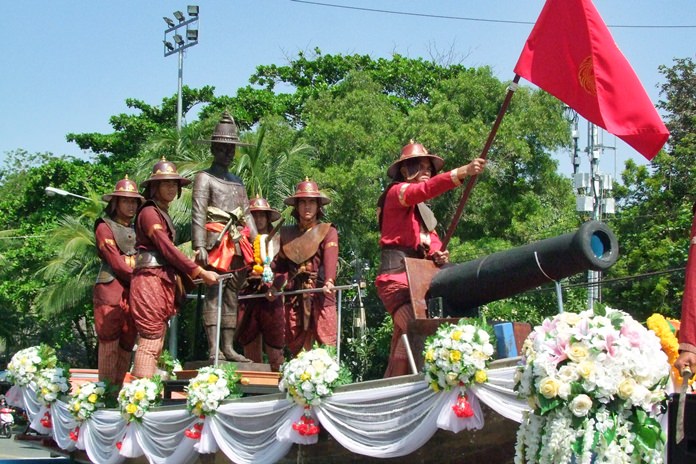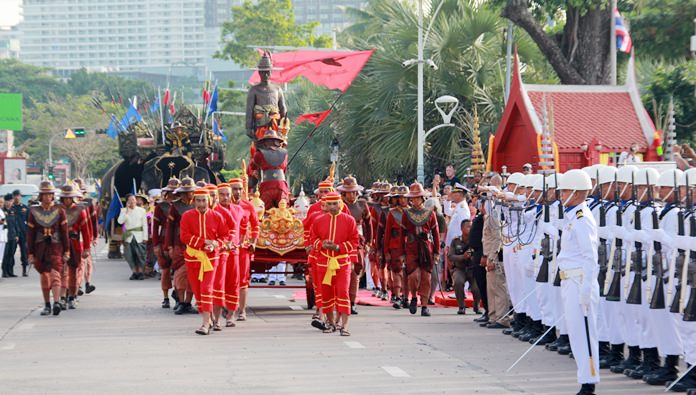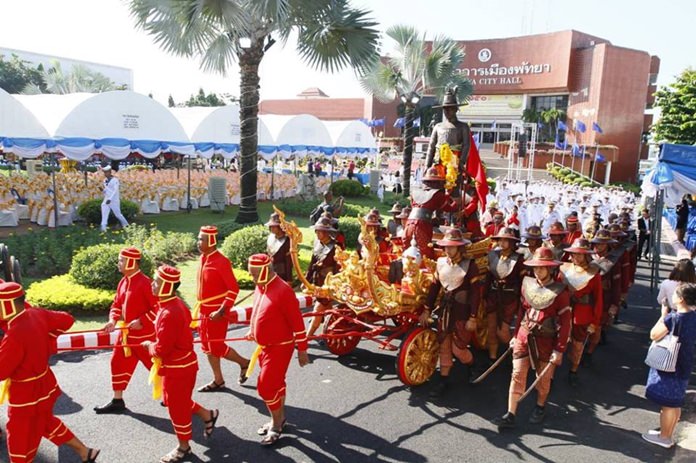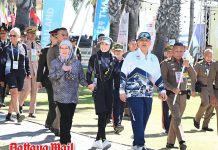
Horses and elephants again walked the streets of Pattaya in a grand parade and re-enactment as the government and navy marked the 250th anniversary of King Taksin the Great’s march through Pattaya to liberate Ayutthaya.
Following a blast of 4,000 firecrackers, navy troops in period costumes and uniformed officers disembarked into smaller boats from the HTMS Angthong docked 1.5 nautical miles offshore and, along with a flotilla of about 100 fishing boats and jet skis, landed on Pattaya Beach at Soi 6 Oct. 29.
They carried to shore a statue of the only king of Thonburi for a parade from the beach to city hall that included elephants, cavalry, dancers in period dress and more.
In all there were 14 segments of the parade with 1,000 people marching. It was led by an open brigade in 18th century uniform followed by cavalry troops with five horses, warlords and generals, the war elephants and their troops, an artillery brigade, members of the public wearing period dress, a supplies brigade and a private brigade.
Banglamung District Chief Naris Niramaiwong and Pattaya Mayor Sonthaya Kunplome led government workers and the public in paying homage to the great king, whose ties to the Pattaya area stem from 1767, when he battled his way out of a besieged Ayutthaya and fled to Chonburi and Rayong to raise an army of 500 to return to free the capital.
To commemorate the 250th anniversary of the epic campaign, the navy held symbolic re-enactments of the long journey by sea, land and river, tracing the route that King Taksin took. Following Pattaya, the caravan proceeded to Chonburi and ended at the historical battleground of Pho Sam Ton Camp in Ayutthaya on Nov. 6, although ceremonies continue until Nov. 11.
At city hall, flowers were arranged in a lotus shape while fireworks exploded. Stage performances told of his heroic battle to free Ayutthaya from the Burmese, with other entertainers performing fire shows, dances and films, including the Sanctuary of Truth’s “King Taksin East Region”, and Legend of Siam’s “Sri Wilai of Siam”.
Taksin took the throne as the king of Thonburi Dec. 28, 1768 and reigned until his death and the start of the current Chakri Dynasty in 1782. He is greatly revered by Thais for leadership in liberating Siam from Burmese occupation after the second fall of capital Ayutthaya in 1767, and the subsequent unification of Siam after it fell under various warlords.
He established the city of Thonburi, across the Chao Phraya River from the current Bangkok, as the new capital, as Ayutthaya has been almost completely destroyed by the invaders.
The scene played out again in Chonburi on Oct. 30 as Gov. Pakarathorn Thienchai welcomed the statue of the king and his troops to Intaram Royal Temple in Muang District.
Brahmins delivered the prayers and sermon for King Taksin’s spirit after which the statue was placed on a parade float for the ride to Bangsaen Beach where it was again loaded on to the HTMS Angthong to make its way to Chachoengsao Province.










 |
 |





